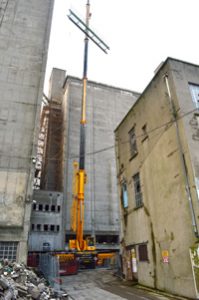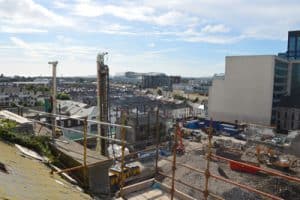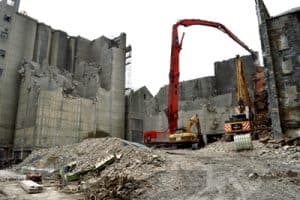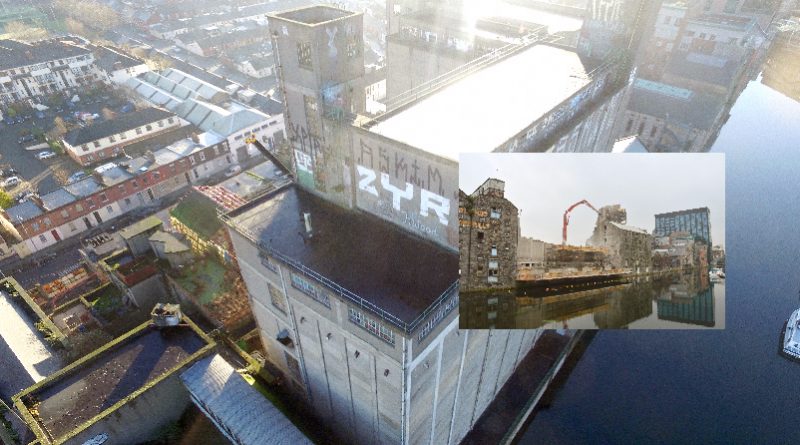History in the making at Boland’s Quay
Hegarty Demolition was awarded the demolition and enabling works at the iconic Boland’s Quay development following a competitive tendering process. The team tell Irish building magazine about the process behind the project.
In July of 2016, Hegarty Demolition completed demolition works at Boland’s Quay, formerly Boland’s Mills. This demolition of three concrete silos and several other substantial concrete structures, which were built in the 1950s, and subsequent enabling works were carried out in less than eight months and serve to forever change the cityscape of our nation’s capital.
Hegarty Demolition
Sean Hegarty Earthworks Ltd. founded in 1971 – specialising in Earthmoving, Site Development, Civil Engineering, Plant Hire and demolition.
Over the years, Urban Development, involving Demolition and Ancillary Works became a substantial part of our workload. Major projects in Guinness Brewery and Custom House Dock Development led to the formation of a separate company – Hegarty Demolition Ltd. – specializing in Demolition, Structural Conservation, Temporary Works and Enabling Works, in 1990.
The company structure now, with Sean Hegarty as Chairman, Liam Hogan – Managing Director, Paul Hogan – Director and Jim Duffy – Director of Estimating & Surveying, has an experienced, professional and dedicated Board of Directors to oversee the range of activities to provide a professional service in Demolition, Civil Engineering and Enabling Works – in which it is now engaged.
Behind the Project
Designed by some of the countrys leading design and development companies led by, Burke Kennedy Doyle, ARUP, Linesight & Cleary McCabe & Associates, Boland’s Quay will provide three new landmark buildings comprising approximately 36,851 square metres (approx. 397,000 sq ft) of office, residential, retail and cultural space. The development will also involve the restoration of a number of protected mill buildings and the creation of a new civic plaza looking onto the waterfront at Grand Canal Dock. A new pedestrian bridge will link the plaza to Ringsend Road. On completion, Boland’s Quay will accommodate up to 2,500 workers.
Scope of Works
The Project involved the demolition and removal of several in-situ concrete structures along with 3 no. substantial concrete silo structures up to 55 metres in height, the dismantling and salvage for re-use of the old factory building, the design and installation of elaborate temporary works support system to retained structures, the design and erection of scaffolding to most facades, the design and fabrication of a cantilevered steel protection apron over the Grand Canal adjoining the works to safeguard the canal wall and basin.
The enabling works package included the installation of a secant piled wall to the perimeter of the full site together with associated supporting anchors and temporary propping to secant wall to allow for the bulk excavation and disposal of 45,000 cubic metres, reaching 10 metres deep in basement excavation.
The Challenge
“The challenge of taking down a number of buildings that were up to 55 metres in height, which stood beside and attached to listed buildings of huge significance to the city, and overlooking the canal was one of the main pressure points of this project for us,” explains Liam Hogan, Hegarty Demolition Managing Director. “In order to carry out the demolition in the safest and most innovative way possible, we acquired the largest specialist Hitachi 870 UHD high-reach machine from Holland. The logistics of shipping the machinery to Ireland, getting it on site and completing the project without any incident was one of the proudest achievements for us on this project.”
Meeting the Challenge
• Augmenting existing 28 metre high-reach machine by sourcing the longest high-reach machinery available in Europe.
• Designing scaffolding and hoisting towers to access and protect elevations where they had to be lowered to a suitable height within the reach of the specialist plant.
• Scaffolded full elevations to protect retained listed structures and to facilitate the separation of buildings by hand.
• Reducing various sections of the buildings i.e. stairwells and plant rooms in height by sawing into small sections and craning to ground level to isolate and leave the building reachable by Ultra High-Reach Machine.
• Appointing a strong and experienced management team to supervise the execution of the works:
Project Director: Liam Hogan
Project Manager/Coordinator: Noel Gill
Site Manager: Joe Coleman
Safety, Health & Environmental Management: Michael Earley & Brian Murphy

The industry has changed dramatically in the forty-some years that Liam Hogan has been with Hegarty Demolition. He cites advances in specialist plant being available and new technology deployed specifically for demolition works as the single biggest change of the last four decades. “The industry has changed significantly over the last forty years. The introduction of robotics and high-reach machinery has changed the face of demolition,” he says. “Health and safety is always at the forefront of our minds, but technology has turned demolition from a very dangerous industry, which was carried out manually to one that aided by robotics and high-reach machinery as well as scaffolding and hoists into one that is extremely safe.”
Jim Duffy, director of Hegarty Demolition, says that the works at Boland’s Quay gave them the opportunity to flex their muscles and excel in terms of carrying out works in an environment of such significance in Irish history. “Boland’s Mills was an iconic structure in the city. When I first saw these buildings there were no high-rise buildings in the area and the buildings dwarfed the artisan buildings in the general area. It was a full working mill up until the 1970s and local people would have worked there so it is firmly ingrained in the fabric of local culture.” Dealing with the sheer size of the silos was a huge component of the project management. “Its height presented new challenges for us and despite the fact that we acquired the highest high-reach machinery available in Europe at the time we still had to take a lot of the building down by hand which involved scaffolding on the different facades of the building – some of which were up to 55 metres high. Th e upper levels of the silos had to be fully scaffolded in order to reduce the structure to a height reachable for the 45 metre capability of the high-reach machine.”
e upper levels of the silos had to be fully scaffolded in order to reduce the structure to a height reachable for the 45 metre capability of the high-reach machine.”
During the fifteen months that Hegarty Demolition worked on site at Boland’s Quay, they employed around fifty people on the project including engineers, health & safety advisors, on site management, skilled demolition operatives and specialist sub – contractors, Hegarty Demolition oversaw the entire project from the demolition works through to enabling works. Noel Gill was project manager on site. “I worked with all teams on the project, from the design team down to the local residents ,” he says. “The logistics on this project were critical; there were lots of different elements that required very high levels of planning.” Noel Gill says that the location of the project offered one of its greatest challenges. “Grand Canal Dock is a hugely busy area. It’s home to a lot of office space and residential units, so to carry out the scale of demolition in a live environment was an ongoing challenge for us. We managed to do it with minimal impact on our neighbours.”
Liam Hogan says that successful project management and inter-team relationships are the reason the project was so successful. “We had no complaints or damage and completed it without any problems, and that is down to the way that the project was managed. It was one of the highest buildings that was ever taken down in the city.”
The demolition works was completed within the programmed eight months efficiently, safely and without incident.
 Hegarty Demolition were a natural fit for the project, as they are renowned as one of the leading demolition and enabling works contractors in the country. Their success, says Liam Hogan, is in their programme management. “We have the best reputation in town for demolition projects, because of our health and safety practices and programme management,” he attests. “We have the ability and facilities to carry out enabling work, which in this project involved piling, retention works and deep excavation. We were able to direct and manage the entire project, to the value in excess of €10 million. We competed with some of the biggest companies in the country, and we were chosen because we could provide the service on time, within budget and ready for the building project to begin.”
Hegarty Demolition were a natural fit for the project, as they are renowned as one of the leading demolition and enabling works contractors in the country. Their success, says Liam Hogan, is in their programme management. “We have the best reputation in town for demolition projects, because of our health and safety practices and programme management,” he attests. “We have the ability and facilities to carry out enabling work, which in this project involved piling, retention works and deep excavation. We were able to direct and manage the entire project, to the value in excess of €10 million. We competed with some of the biggest companies in the country, and we were chosen because we could provide the service on time, within budget and ready for the building project to begin.”
Maintaining excellent client relationships are the hallmarks of Hegarty Demolition’s business ethos, according to Liam Hogan. “Why do our clients choose us again and again? We provide an extremely professional service to both main contractors and as a stand alone enabling works contractor and subcontractor. Our reputation is the reason that we get repeat work. We work extremely well with people,” he states. “We work with all of the main contracting companies in the country and have an excellent working relationship with them all – we pride ourselves on our ability to create lasting relationships. My principle with dealing with people is that the customer is always right. If you start there, you don’t go too far wrong. We provide an extremely personal service to our clients, and that’s reflected in our lasting relationships. Being in the business for over 40 years, we have worked with different generations of main contractors, professional personnel and local authorities so our capabilities and knowledge have been well earned.”
According to Jim Duffy, these relationships have allowed Hegarty to evolve as a company and develop in all aspects of construction from construction itself, demolition and retention, civil engineering, conservation works and the construction of deep basements.. “Because of our reputation, design teams trust us to carry out the role of PSCS on any project,” he explains. “We can take it from tender to completion. This full service offering is one of Hegarty Demolition’s greatest selling points.”
The demolition of the silos at Boland’s Quay marked a significant upturn for Hegarty Demolition, which Duffy points out with refreshing frankness. “It got us back working again after the recession. This was the first substantial project in the new era of the Irish construction industry. This job was the start of the main development of the whole area surrounding Grand Canal Dock, and there was a lot of focus on it. It really kick-started things for us. We were a natural fit for the job for many reasons – before the recession we had worked on numerous substantial demolition projects and had removed some similar but substantial silos up to 40 metres high on the adjoining site, so were familiar with the area and its demands.”
 The works provided a huge morale boost for the team at Hegarty Demolition, says Duffy. “This project offered us the opportunity to exercise our full expertise and teamwork capabilities again and I cannot over-estimate the minute planning and details that went into the project, because everything had to be monitored on a day by day process for the full eight months”. The detail in which the project was managed was a testament to the commitment to excellence that Hegarty Demolition is known for. “Everything was planned down to the last detail to ensure that the works were executed in the safest environment possible.”
The works provided a huge morale boost for the team at Hegarty Demolition, says Duffy. “This project offered us the opportunity to exercise our full expertise and teamwork capabilities again and I cannot over-estimate the minute planning and details that went into the project, because everything had to be monitored on a day by day process for the full eight months”. The detail in which the project was managed was a testament to the commitment to excellence that Hegarty Demolition is known for. “Everything was planned down to the last detail to ensure that the works were executed in the safest environment possible.”
Upon completion of the demolition works at Boland’s Quay, Development Director of the BQDG, Michael Cleary commented, “This was a complicated process due to the site’s proximity to the water and credit must go to Hegarty Demolition for their work in completing this task in a safe and timely manner.” Harnessing their collective skills of demolition, structural piling, civil works and conservation works, Hegarty Demolition has solidified their position as leaders in their field.
The project marks the beginning of a new phase for the company, says Jim Duffy. “It was a project that came after the worst recession we have ever lived through and it absolutely galvanised us and gave us the impetus to get the company back up and firing on all cylinders. The job itself will sustain and enhance our reputation and prequalify us for projects that come on stream.” With live projects currently in place across the country in a variety of locations, each with their own unique pressure points, the future has never been brighter for Hegarty Demolition.
The contents of this site are subject to copyright laws and may not be reproduced in any form without the prior consent of the publishers. The views expressed in articles do not necessarily represent those of the publishers.
[rev_slider Surety]

